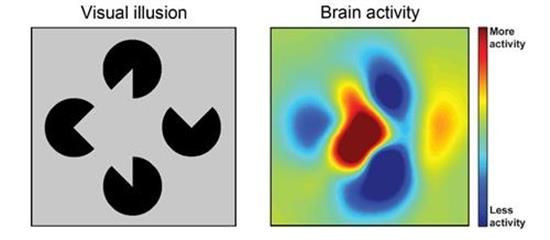Active Interpretation By The Brain Helps In Perception

Using the images we associate with a common video game and an fMRI technique, researchers from Radboud University discovered that the brain actively interprets visual signals early on in signal processing. In other words, we see not only with our eyes, but with our brain, too. This challenges earlier theories that state visual processing occurs outside the brain.
This new study, published in the July edition of Current Biology, is based on the visual illusion that the brain presents. For example, the "Pac-Man" shapes consist of only circles with a portion cut-off. There is no triangle, but the positions of the circles convey an illusion of a triangle placed on top of the circles. The illusion of the triangle, the research shows, is on account of the initial processing done by the brain.
The scientists tried to explore how the brain creates this illusion and found through fMRI that the triangle — although non-existent — activates the primary visual brain cortex. This is part of the neocortex that receives visual inputs from the retina. According to the new research, the primary visual cortex is not just involved in processing the eye signals but is involved in active interpretation, according to Kok and De Lange.
Several other theories have also stated that the brain just does not merely reproduce the retinal image but is involved in active interpretation. If it didn’t do this, we would only see the image captured in the retina. But this does not happen and the perceptions change even when the image in the retina stays the same.
In the example described above, the brain decides it is more likely that a triangle would be on top of black circles than that three such circles, each with a bite taken out, would by coincidence point in a particular direction. After all, when we look around, we see triangles and circles more often than Pac-Man shapes.
Furthermore, the brain is used to the idea of things being stacked on top of each other. In our everyday lives we see several examples of stacked objects, like a pile of books on the desk. So the imaginary triangle is a feasible explanation for the bites taken out of the circles; the brain "understands" they are "merely" partly covered black circles.
The unexpected requires more processing Kok and De Lange also noticed that whenever the Pac-Man shapes do not form a triangle, more brain activity is required. But when it encounters something unexpected, the brain is more active in processing it, like when the Pac-Man shapes do not form a triangle.
In the above image on the right, we see that the three Pac-Man shapes "underneath" the triangle cause little brain activity (coloured blue), but the separate Pac-Man on the right causes more activity.
Author V.S Ramachandran in his book Phantoms in the brain says, "Every act of perception, even something as simple as viewing a drawing of a cube, involves an act of judgement by the brain." This also fits in with the theory that perception is a question of interpretation, since something easy to explain requires less brain activity compared to something unexpected or difficult.
Source: Kokemail P, de Lange F, Shape Perception Simultaneously Up- and Down regulates Neural Activity in the Primary Visual Cortex. Current Biology. 2014.



























